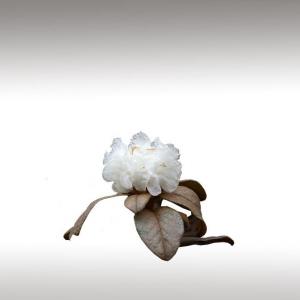
RHODODENDRON ESSENTIAL OIL (RHODODENDRON ANTHOPOGON D. DON) - ESSENTIAL OILS

BASE / GENERAL DATA
Information submited: June 9, 2016 Modified: March 15, 2018 By: OperaDreamhouse
Botanical Name: Rhododendron anthopogon D. Don
Botanical Origin: Nepal
Common Method of Extraction: Steam distilled
Part Typically Used: Flowers and leaves
Color: Pale yellow
Consistency: Thin liquid
Perfumery Note: Middle
Shelf Life: 3-4 years
Strength of Initial Aroma: Fresh, exotic floral, sweet, fruity, slightly balsamic with herbaceous undertone. This essential oil has an exotic floral aroma with lingering sweet fruity notes.
Blends Well With: Black spruce, clary sage, davana,fir needle siberian, geranium egypt, ginger fresh, lavender, orange sweet, palmarosa essential oils.
Common name : Sunpati oil, Anthopogon oil, Balu ot sunpati.
Chemical structure: The oil was characterized by a high amount of monoterpene hydrocarbons (76.1%), mainly α- pinene (37.4%), followed by β-pinene (16.1%), limonene (13.3%), and the sesquiterpene, δ-cadinene (9.1%). Leaves produce aromatic oil containing a- and b- pinine, d-limonene, 3-cyclohexene, linalyl proponate, butonaic acid, caryophyllene, coapene, caryophyllene , copaene , caryophyllene oxide , guaiol ,o-selinene2- nepathalimine.
Note: Only the Rhododendron Anthopogon species is distilled as it has fragrant leaves and is non toxic. This is one essential oil that is species specific, the species being anthopogon. The rest of the Rhododendron genus is highly toxic and should not be distilled.
There are more than 850 different natural species in the Genus (group) Rhododendron. They are native to the temperate regions of Asia, North America, and Europe, as well as to the tropical regions of southeast Asia and northern Australia.
An evergreen shrub growing at an altitude of 3,000 - 4,000 m a.s.l., harvested in several regions of Nepal. This plant is a national symbol in Nepal and is widely used as incense for its aromatic properties. It is known more for its brilliant blossoming that covers hillsides from Bhutan to central Nepal, few have encountered its fragrant and unique scent.
It is an evergreen, strongly aromatic shrub-let too 60 cm to 1 m tall. Leaves simple, alternate, short stalked, oval to ovate, 2,5 - 4 cm long, densely scaly beneath and aromatic characteristic smell when crushed. Flowers white or yellowish tinged with pink, 4 - 6 in compact terminal clusters. fruits capsules, about 3 mm long, enriched by persistent calyx. It is in leaf all year, in flower form April to May, and the seeds riped from July to August.
Anthopogon oil, as it is usually referred to in Nepal, is obtained by steam distillation of the aerial parts of Rhododendron Anthopogon.
Botanical Origin: Nepal
Common Method of Extraction: Steam distilled
Part Typically Used: Flowers and leaves
Color: Pale yellow
Consistency: Thin liquid
Perfumery Note: Middle
Shelf Life: 3-4 years
Strength of Initial Aroma: Fresh, exotic floral, sweet, fruity, slightly balsamic with herbaceous undertone. This essential oil has an exotic floral aroma with lingering sweet fruity notes.
Blends Well With: Black spruce, clary sage, davana,fir needle siberian, geranium egypt, ginger fresh, lavender, orange sweet, palmarosa essential oils.
Common name : Sunpati oil, Anthopogon oil, Balu ot sunpati.
Chemical structure: The oil was characterized by a high amount of monoterpene hydrocarbons (76.1%), mainly α- pinene (37.4%), followed by β-pinene (16.1%), limonene (13.3%), and the sesquiterpene, δ-cadinene (9.1%). Leaves produce aromatic oil containing a- and b- pinine, d-limonene, 3-cyclohexene, linalyl proponate, butonaic acid, caryophyllene, coapene, caryophyllene , copaene , caryophyllene oxide , guaiol ,o-selinene2- nepathalimine.
Note: Only the Rhododendron Anthopogon species is distilled as it has fragrant leaves and is non toxic. This is one essential oil that is species specific, the species being anthopogon. The rest of the Rhododendron genus is highly toxic and should not be distilled.
There are more than 850 different natural species in the Genus (group) Rhododendron. They are native to the temperate regions of Asia, North America, and Europe, as well as to the tropical regions of southeast Asia and northern Australia.
An evergreen shrub growing at an altitude of 3,000 - 4,000 m a.s.l., harvested in several regions of Nepal. This plant is a national symbol in Nepal and is widely used as incense for its aromatic properties. It is known more for its brilliant blossoming that covers hillsides from Bhutan to central Nepal, few have encountered its fragrant and unique scent.
It is an evergreen, strongly aromatic shrub-let too 60 cm to 1 m tall. Leaves simple, alternate, short stalked, oval to ovate, 2,5 - 4 cm long, densely scaly beneath and aromatic characteristic smell when crushed. Flowers white or yellowish tinged with pink, 4 - 6 in compact terminal clusters. fruits capsules, about 3 mm long, enriched by persistent calyx. It is in leaf all year, in flower form April to May, and the seeds riped from July to August.
Anthopogon oil, as it is usually referred to in Nepal, is obtained by steam distillation of the aerial parts of Rhododendron Anthopogon.

SPIRITUAL PRACTISES DATA
Information submited: June 9, 2016 Modified: February 19, 2018 By: OperaDreamhouse
Most significant, Anthopogon has been collected and gathered by high Himalayan people from Dolpo, Mustang to the Sherpas and Bhutanese as a scared fragrant substance to be burnt in offering to please and harmonize the earthly divine-especially local earth spirit. It is one five common Himalayan incense herbs symbolizing the elements that are offered to sanctify and pacify the environment.
An interesting spiritual fact is that the dried leaves of Rhododendron Anthopogon are crushed by Buddhist monks, mixed with Ghee, and made into sacred incense for their monasteries and others throughout SE Asia.
This is a wonderful calming oil for meditation or chanting to help makespiritual connections by opening the mind and heart to a free flow of positive energy through its grounding, calming, and centering properties.
Emotional grounding and settling, it is known to quiet mental activity, which is a valuable tool in meditation practice: Protection, grounding, cleanse, consecrate, confidence, attract positive energy flow, creativity, scrying, meditation, reiki, chanting, all spiritual working and connections, anointing, opening the 3rd Eye and working with the 4th Heart Chakra.
This essential oil helps to call and allow in all that you want to manifest in life.
An interesting spiritual fact is that the dried leaves of Rhododendron Anthopogon are crushed by Buddhist monks, mixed with Ghee, and made into sacred incense for their monasteries and others throughout SE Asia.
This is a wonderful calming oil for meditation or chanting to help makespiritual connections by opening the mind and heart to a free flow of positive energy through its grounding, calming, and centering properties.
Emotional grounding and settling, it is known to quiet mental activity, which is a valuable tool in meditation practice: Protection, grounding, cleanse, consecrate, confidence, attract positive energy flow, creativity, scrying, meditation, reiki, chanting, all spiritual working and connections, anointing, opening the 3rd Eye and working with the 4th Heart Chakra.
This essential oil helps to call and allow in all that you want to manifest in life.

MEDICINE / HEALTH DATA
Information submited: June 9, 2016 Modified: March 15, 2018 By: OperaDreamhouse
Therapeutic Properties :
Anti-inflammatory
Antibacterial
Decongestant
Nervous system calming
Antispasmodic
Antibacterial
Antibacterial decongestant
Nervous tonic
Analgesic.
Contraindications : None. Considered Non-toxic, non-irritant, non-sensitizing. Do not take Rhododendron essential oil internally.
Pregnancy / Lactation : No database.
Children: No database.
Rhododendron essential oil can be applied topically, as a compress, in the bath, through direct inhalation, or used with a diffuser.
Tibetan medicinehas long used dried Rhododendron in herbal teas to stoke the digestive fire, to treat heat-related headaches as well as sore throats and nausea, and to promote inner unity.
According to Himalayan aromatherapy, this oil stimulates the nervous system and has been used for treating sore muscles and gout rheumatic conditions. In the nervous system, Rhododendron's tonifying properties support relaxation and centering.
A general tonic to the system, Rhododendron oil can be applied topically (synergistically blended with Frankincense and German Chamomile) to help reduce inflammation, or can be applied as a compress over the upper abdomen to support adrenal and liver function.
the oil is able to reduce cancer cell growth independently of the cell line and the treatment protocols used.
Its leaves and fresh flowers are made into a tea by Himalayan healers and drunk to promote digestive heat, stimulate appetite and relieve liver disorders. Its tea is also drunk for sore throat, and to counteract water earth illness, fire headaches, fire back pain, cold, bloode disorders, bone disease, potato allergies, and vomiting.
Anti-inflammatory
Antibacterial
Decongestant
Nervous system calming
Antispasmodic
Antibacterial
Antibacterial decongestant
Nervous tonic
Analgesic.
Contraindications : None. Considered Non-toxic, non-irritant, non-sensitizing. Do not take Rhododendron essential oil internally.
Pregnancy / Lactation : No database.
Children: No database.
Rhododendron essential oil can be applied topically, as a compress, in the bath, through direct inhalation, or used with a diffuser.
Tibetan medicinehas long used dried Rhododendron in herbal teas to stoke the digestive fire, to treat heat-related headaches as well as sore throats and nausea, and to promote inner unity.
According to Himalayan aromatherapy, this oil stimulates the nervous system and has been used for treating sore muscles and gout rheumatic conditions. In the nervous system, Rhododendron's tonifying properties support relaxation and centering.
A general tonic to the system, Rhododendron oil can be applied topically (synergistically blended with Frankincense and German Chamomile) to help reduce inflammation, or can be applied as a compress over the upper abdomen to support adrenal and liver function.
the oil is able to reduce cancer cell growth independently of the cell line and the treatment protocols used.
Its leaves and fresh flowers are made into a tea by Himalayan healers and drunk to promote digestive heat, stimulate appetite and relieve liver disorders. Its tea is also drunk for sore throat, and to counteract water earth illness, fire headaches, fire back pain, cold, bloode disorders, bone disease, potato allergies, and vomiting.

BEAUTY / COSMETICS DATA
Information submited: June 9, 2016 Modified: February 21, 2018 By: OperaDreamhouse
This oil is a good natural source of sweet herbal, a faintly balsamic essence Rhododendron Anthopogon essential oil can be used on the skin and hair.
According to Himalayan aromatherapy, Rhododendron has grounding, calming, and centering properties.
According to Himalayan aromatherapy, Rhododendron has grounding, calming, and centering properties.

FOOD / COOKING DATA
COMMENTS
No comments.


